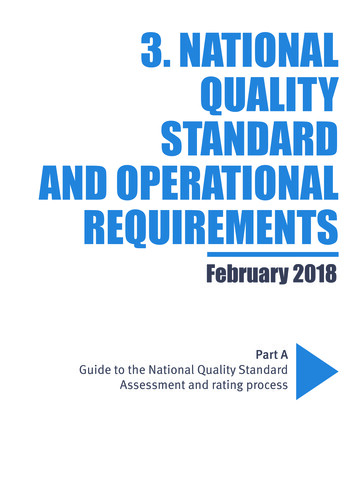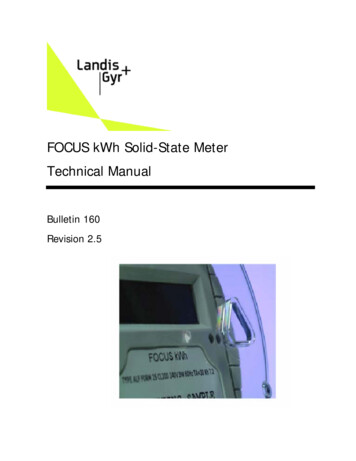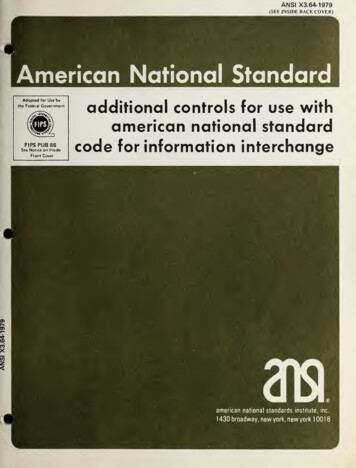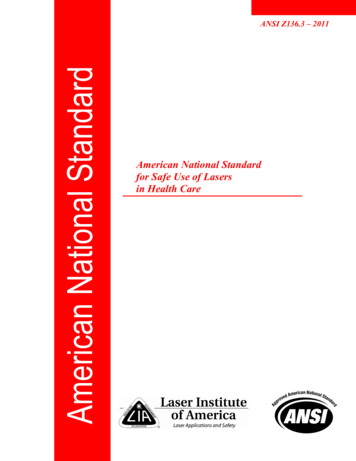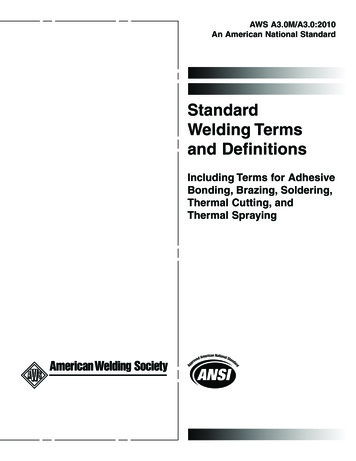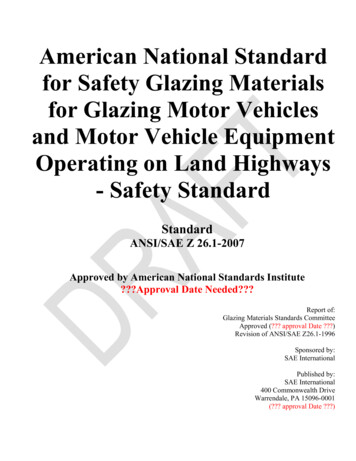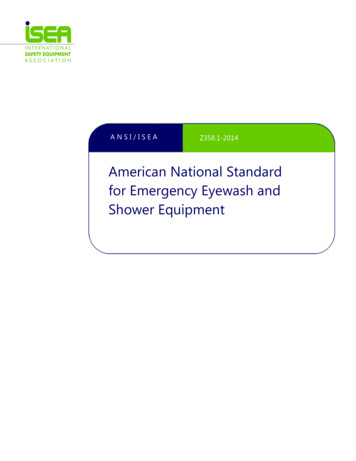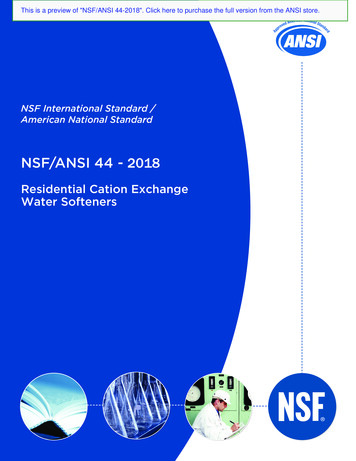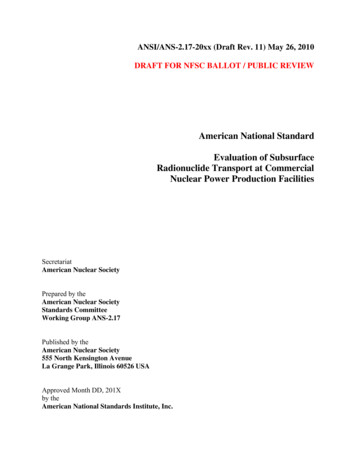
Transcription
ANSI/ANS-2.17-20xx (Draft Rev. 11) May 26, 2010DRAFT FOR NFSC BALLOT / PUBLIC REVIEWAmerican National StandardEvaluation of SubsurfaceRadionuclide Transport at CommercialNuclear Power Production FacilitiesSecretariatAmerican Nuclear SocietyPrepared by theAmerican Nuclear SocietyStandards CommitteeWorking Group ANS-2.17Published by theAmerican Nuclear Society555 North Kensington AvenueLa Grange Park, Illinois 60526 USAApproved Month DD, 201Xby theAmerican National Standards Institute, Inc.
AmericanNationalStandardDesignation of this document as an American National Standard attests that the principles of openness anddue process have been followed in the approval procedure and that a consensus of those directly and materially affected by the standard has been achieved.This standard was developed under the procedures of the Standards Committee of the American NuclearSociety; these procedures are accredited by the American National Standards Institute, Inc., as meeting thecriteria for American National Standards. The consensus committee that approved the standard was balanced to ensure that competent, concerned, and varied interests have had an opportunity to participate.An American National Standard is intended to aid industry, consumers, governmental agencies, and generalinterest groups. Its use is entirely voluntary. The existence of an American National Standard, in and of itself, does not preclude anyone from manufacturing, marketing, purchasing, or using products, processes, orprocedures not conforming to the standard.By publication of this standard, the American Nuclear Society does not insure anyone utilizing the standardagainst liability allegedly arising from or after its use. The content of this standard reflects acceptable practice at the time of its approval and publication. Changes, if any, occurring through developments in the stateof the art, may be considered at the time that the standard is subjected to periodic review. It may be reaffirmed, revised, or withdrawn at any time in accordance with established procedures. Users of this standardare cautioned to determine the validity of copies in their possession and to establish that they are of the latest issue.The American Nuclear Society accepts no responsibility for interpretations of this standard made by anyindividual or by any ad hoc group of individuals. Requests for interpretation should be sent to the StandardsDepartment at Society Headquarters. Action will be taken to provide appropriate response in accordancewith established procedures that ensure consensus on the interpretation.Comments on this standard are encouraged and should be sent to Society Headquarters.Published byAmerican Nuclear Society555 North Kensington AvenueLa Grange Park, Illinois 60526 USACopyright 201X by American Nuclear Society. All rights reserved.Any part of this standard may be quoted. Credit lines should read “Extracted from American National StandardANSI/ANS-2.17-201X with permission of the publisher, the American Nuclear Society.” Reproduction prohibited undercopyright convention unless written permission is granted by the American Nuclear Society.Printed in the United States of Americai
Foreword(This Foreword is not a part of American National Standard “Evaluation of Subsurface Radionuclide Transport at Commercial Nuclear Power Production Facilities”, ANSI/ANS-2.17-201X.)This standard constitutes a major revision of the original standard, ANSI/ANS-2.171980, which was adopted on April 9, 1980, reaffirmed on October 3, 1989, and withdrawn on July 28, 2000. A new working group, Working Group ANS-2.17 of ANS-25Subcommittee (Siting: Environmental & Emergency Preparedness) of the AmericanNuclear Standards Committee, was constituted November 2005 to revise the originalstandard.This standard might reference documents and other standards that have been supersededor withdrawn at the time the standard is applied. A statement has been included in thereferences section that provides guidance on the use of references.This standard mentions, but does not exhaustively describe, the concepts of generatingrisk-informed insights, performance-based requirements, and a graded approach to quality assurance. The user is advised that one or more of these techniques could enhancethe application of this standard.Two appendices are provided to assist practitioners who would implement the guidancein this standard. Appendix A provides information on relevant U.S. Nuclear RegulatoryCommission regulatory criteria and guidance, and its Table A provides a listing of standard documents (e.g., ANS, ASTM, ISO, etc) for conducting subsurface radionuclidetransport characterization, monitoring, and modeling programs. Appendix B providestables that summarize information and parameters identified in the guidance.ii
The ANS-2.17 Working Group of the Standards Committee of the American Nuclear Society had the following membership:J. S. Bollinger (Co-Chair), Savannah River National LaboratoryT. C. Rasmussen (Co-Chair), University of GeorgiaM. J. Barvenik, GZA GeoEnvironmental, Inc.R. L. Beauheim, Sandia National LaboratoriesG. S. Bodvarsson1, Lawrence Berkeley National LaboratoryJ. M. Godfrey, Southern Nuclear CompanyD. Goswami, Washington State Department of EcologyV. Guvanasen, HydroGeoLogic, Inc.C. D. Martinec, Duke EnergyP. D. Meyer, Pacific Northwest National LaboratoryF. J. Molz, III, Clemson UniversityT. J. Nicholson, U.S. Nuclear Regulatory CommissionD. Scott, Radiation Safety and Control Services, Inc.E. P. Weeks, U.S. Geological SurveyD. G. Wells, Washington Savannah River CompanyM. H. Young, Desert Research InstituteThis standard was prepared under the guidance of Subcommittee ANS-25, Siting: Environmental &Emergency Preparedness, of the American Nuclear Society. At the time of the ballot, SubcommitteeANS-25 was composed of the following members:K. R. Bryson (Chair), Shaw Environmental, Inc.C. A. Mazzola (Vice Chair), Shaw Environmental, Inc.J. S. Bollinger, Savannah River National LaboratoryC. Costantino, IndividualA. N. Findikakis, Bechtel CorporationC. Guggino, Bechtel CorporationD. Hang, IndividualK. Hanson, AMEC GeomatrixJ. J. Litehiser, Bechtel CorporationT. C. Rasmussen, University of GeorgiaJ. D. Stevenson, IndividualL. W. Vail, Pacific Northwest National LaboratoryS. A. Vigeant, Shaw Environmental & Infrastructure1The working group would like to gratefully acknowledge the contributions by G.S. “Bo” Bodvarsson, who diedprior to the completion of this standard.iii
The standard was processed and approved for submittal to ANSI by the Nuclear Facilities StandardsCommittee (NFSC) of the American Nuclear Society. Committee approval of the standard does not necessarily imply that all members voted for approval. At the time it approved this standard the NFSC hadthe following membership:C. A. Mazzola (Chair), Shaw Environmental & Infrastructure, Inc.R. M. Ruby (Vice Chair), Constellation EnergyJ. K. August, CORE, Inc.W. H. Bell, South Carolina Electric & Gas CompanyJ. R. Brault, Shaw MOX ProjectC. K. Brown, Southern Nuclear Operating CompanyR. H. Bryan, Tennessee Valley AuthorityK. R. Bryson, Shaw Environmental, Inc.C. E. Carpenter, U.S. Nuclear Regulatory CommissionT. Dennis, IndividualD. R. Eggett, Automated Engineering Services CorporationR. W. Englehart, IndividualP. Guha, U.S. Department of EnergyR. Hall, Exelon Generation Company, LLCP. S. Hastings, Duke EnergyR. A. Hill, ERIN Enginneering and Research, Inc.N. P. Kadambi, IndividualE. M. Lloyd, Exitech CorporationE. P. Loewen, General ElectricS. A. Lott, Los Alamos National LaboratoryJ. E. Love, Bechtel Power CorporationR. H. McFetridge, Westinghouse Electric CorporationC. H. Moseley, ASME/NQA Liaison (BWXT Y-12)D. G. Newton, AREVA NPW. N. Prillaman, AREVA NPW. B. Reuland, IndividualD. J. Spellman, Oak Ridge National LaboratoryS. L. Stamm, Shaw Nuclear ServicesJ. D. Stevenson, IndividualJ. A. Wehrenberg, Southern Nuclear Operating CompanyM. J. Wright, Entergy Operations, Inc.iv
ContentsSectionPage1.0 SCOPE12.0 DEFINITIONS22.1 Acronyms and Initialisms2.2 Definition of Terms223.0 PERFORMANCE ASSESSMENT METHODOLOGY93.1 Performance Assessment Activities3.2 Performance Assessment Elements9124.0 SITE CHARACTERIZATION154.1 Conceptual Site Model4.2 Facilities Characterization4.3 Hydrogeologic Characterization1517185.0 MATHEMATICAL MODELING235.1 Model Scope5.2 Calibration, Prediction, and Updating5.3 Uncertainty Assessment2326286.0 PERFORMANCE-CONFIRMATION MONITORING6.1 Types of Monitoring Data6.2 Monitoring Methods6.3 Monitoring Locations and Frequencies303031327.0 INFORMATION MANAGEMENT347.1 Characterization and Monitoring Data Management7.2 Mathematical Model Management34358.0 REFERENCES37APPENDIX A. CONSULTATION AND COORDINATION42APPENDIX B. SUMMARY OF INFORMATION AND PARAMETERS46v
2Evaluation of Subsurface Radionuclide Transport at Commercial Nuclear Power Production Facilities31.0 Scope4This national standard establishes the requirements for evaluating the occurrence and movement of radio-5nuclides in the subsurface resulting from abnormal radionuclide releases at commercial nuclear power6production facilities.7This standard applies to abnormal radionuclide releases that affect groundwater, water supplies derived8from groundwater, and surface waters affected by subsurface transport, including exposure pathways9across the groundwater-surface water transition zone.11011This standard does not apply to: subsurface radionuclide occurrence and movement in soil and groundwater;1213Subsurface occurrence and movement of non-radioactive materials, other than as indicators of Surface occurrence and movement of radionuclides, except to the extent that surface radionuclide14occurrence and movement may affect, or be affected by, onsite subsurface radionuclide occur-15rence and movement (e.g., a surface release that subsequently infiltrates and affects groundwater,16a subsurface release that affects surface water, including exposure pathways across the groundwa-17ter-surface water transition zone);18 Corrective action, which may be required as the result of a subsurface radionuclide release; and19 Dose calculations to demonstrate compliance with any regulatory requirement.201
12.0 Definitions22.1 Acronyms and Initialisms3ALARA: As Low As Is Reasonably Achievable4ANS: American Nuclear Society5ANSI: American National Standards Institute6ASTM: ASTM International, previously known as the American Society for Testing and Materials7CFR: Code of Federal Regulations8CRWMS: Civilian Radioactive Waste Management System Management and Operating Contractor9CSM: Conceptual Site Model10DQOs: Data Quality Objectives11EIS: Environmental Impact Statement12EPRI: Electric Power Research Institute13FEPs: Features, Events, and Processes14IAEA: International Atomic Energy Association15NEI: Nuclear Energy Institute16NGWA: National Ground Water Association17NRC: National Research Council18REMP: Radiological Environmental Monitoring Programs19RETS: Radioactive Effluent Technical Specifications20TEDE: Total Effective Dose Equivalent21U.S.: United States22USEPA: U.S. Environmental Protection Agency2324USNRC: U.S. Nuclear Regulatory Commission2.2 Definition of Terms25Abnormal radionuclide release: An unplanned or uncontrolled release of licensed radioactive material,2
1including leaks and spills to the site environs (e.g., locations outside of nuclear power plant systems,2structures, and components), which may be undetected at the time of the original release.3As low as is reasonably achievable (ALARA): Every reasonable effort is made to maintain exposures to4radiation as far below the dose limits as is practical consistent with the purpose for which the licensed ac-5tivity is undertaken, taking into account the state of technology, the economics of improvements in rela-6tion to state of technology, the economics of improvements in relation to benefits to the public health and7safety, and other societal and socioeconomic considerations, and in relation to utilization of nuclear ener-8gy and licensed materials in the public interest.9Ambient flow: Natural horizontal or vertical groundwater movement through the subsurface; or resulting10from natural hydraulic gradients in an open borehole, well or piezometer.11Aquifer: A geologic formation, group of formations, or part of a formation that contains sufficient satu-12rated permeable material to yield significant quantities of water to springs, seeps, and wells.13Aquifer, confined: An aquifer bounded above by an aquitard.14Aquifer, unconfined: An aquifer whose upper surface is a water table.15Aquitard: A geologic formation that restricts, but does not prevent, groundwater movement into or be-16tween aquifers.17Baseline concentration, local: The concentration or activity of a substance that is indicative of local site18conditions prior to the operation of the nuclear facility.19Baseline concentration, regional: The concentration or activity of a substance that is indicative of re-20gional conditions prior to the operation of the nuclear facility.21Biogeochemical processes: The chemical interactions that exist between the atmosphere, hydrosphere,22lithosphere, and biosphere.23Capillary zone: The region above the water table where pores are saturated, but the water gage pressure24is negative; also called the tension-saturated zone.25Conceptual site model (CSM): An abstract, qualitative representation of the relevant flow and transport26FEPs that affect subsurface radionuclide transport at the site. The CSM is best presented as a set of two-27dimensional graphics (plan and profile) or a three-dimensional graphic (isometric), which qualitatively28present the interrelationships between the FEPs, along with supporting text.29Confining layer: A geologic unit within the saturated or unsaturated zones that has a distinctly lower hy3
1draulic conductivity than the underlying and overlying geologic units; also called an aquitard when in the2saturated zone.3Contamination: Occurrence of material in a location where it is not considered indigenous to its sur-4roundings.5Corrective action: Activities undertaken to manage or remediate the occurrence or movement of subsur-6face radionuclides.7Critical outcome: A long-term, strategic goal, stated in terms of the expected results, that captures the8essence of the desired end state to be achieved.9Data quality objectives (DQOs): Qualitative and quantitative statements derived from the DQO process10that clarify the study objectives, define the most appropriate type of data to collect, determine the most11appropriate conditions from which to collect the data, and specify tolerable limits on decision error rates.12Because DQOs will be used to establish the quality and quantity of data needed to support decisions, they13should encompass the total uncertainty resulting from all data collection activities, including analytical14and sampling activities.15Data quality objective process: A systematic, strategic-planning tool based on the scientific method that16identifies and defines the type, quality, and quantity of data needed to satisfy a specified use. DQOs are17the qualitative and quantitative outputs from the DQO process.18Dual porosity model: A flow and transport model applied to a porous medium composed of two porosity19fractions or domains. One fraction stores and transmits solute (mobile flow domain), while the second20fraction only stores solute (immobile domain). Fluid and solute exchange between the mobile and immo-21bile domains occur as functions of the hydraulic head and concentration gradient between the two, respec-22tively.23Effluent concentration limit: The concentration values (given in Columns 1 and 2 of Table 2 in 10 CFR24Part 20, Appendix B) equivalent to the radionuclide concentrations which, if inhaled or ingested conti-25nuously over the course of a year, would produce a total effective dose equivalent of 0.05 rem (50 milli-26rem or 0.5 millisieverts).27Effluent discharge (radioactive): Any outflow in which plant-related, licensed radioactive material is28released from a system, structure, or component and enters the unrestricted area.29Engineered barrier: A man-made cover, wall, or device used to prevent fluid flow or contaminant mi-30gration.4
1Exposure pathway: A mechanism by which radioactive material is transferred from the (local) environ-2ment to humans. There are three commonly recognized exposure pathways; inhalation, ingestion, and di-3rect radiation. For example, ingestion is an exposure pathway, and it may include dose contributions from4one or more routes of exposure. For example, one route of exposure that may contribute to the ingestion5exposure pathway is often referred to as grass-cow-milk-infant-thyroid route of exposure.6Features, events, and processes (FEP): An assessment of the relevant: 1) Features, which are identified7physical characteristics of the total system, and how they behave over time; 2) Events, which are occur-8rences of abnormal radionuclide releases; and 3) Processes, which include physical, chemical, and biolog-9ical processes that govern radionuclide transport.10Flux: The volumetric or mass discharge per unit cross-sectional area of medium (solids plus pores);11called the Darcian flux when applied to water movement.12Groundwater: All water contained in pores, fractures or voids at or below the water table (also called13the phreatic surface); also identifies water in the phreatic zone.214Groundwater recharge: The process involved in the addition of water to the phreatic zone; also, the15amount of water added to the saturated zone.16Hydraulic gradient: The change in hydraulic head with distance.17Hydraulic head: One of several measures of the energy content of water (in this case, energy per unit18weight), expressed as a height of freshwater above a datum. In fresh groundwater, the hydraulic head is19commonly found using the water surface elevation in an open borehole, well, or piezometer.20Hydrostratigraphy: A conceptual framework that classifies geologic materials of considerable lateral21extent into reasonably distinct hydrologic systems.22Infiltration: The movement of water from above the ground surface into the vadose zone.23Intermediate point of compliance: A location used as a reference point for the purpose of protecting the24groundwater resource, where there are no immediate existing receptors but where contamination is re-25garded as undesirable.26Mathematical model: A quantitative representation of the relevant flow and transport FEPs that affect2Regulatory agencies and industry may consider groundwater to include all subsurface water, so that all contaminants in the subsurface are evaluated, and not only those in the phreatic zone.5
1subsurface radionuclide transport at the site. The mathematical model can be an algebraic equation for2simple, homogeneous systems, or it can be a computer model in more complicated systems.3Normal radionuclide release: The known, planned, or approved release of radionuclides to the environ-4ment, including controlled releases of low-level radioactive materials.5Perched water: Subsurface water collecting on low-permeability geologic materials that are separated6from an underlying main body of groundwater by an unsaturated zone. Water located above the water ta-7ble whose water gage pressure is greater than zero.8Performance assessment: A systematic analysis that addresses the types and likelihood of abnormal ra-9dionuclide releases, their resulting impacts, and how these impacts compare to regulatory standards.10Performance-based regulation: Regulations that are outcome-oriented rather than procedure-oriented.11An approach to regulatory practice that establishes performance and results as the primary bases for deci-12sion making. Performance-based regulations have the following attributes: (1) measurable, calculable or13objectively observable parameters exist or can be developed to monitor performance; (2) objective criteria14exist or can be developed to assess performance; (3) licensees have flexibility to determine how to meet15the established performance criteria in ways that will encourage and reward improved outcomes; and (4) a16framework exists or can be developed in which the failure to meet a performance criterion, while undesir-17able, will not in and of itself constitute or result in an immediate safety concern.18Performance indicator: An observable hydrologic (e.g., water content, water flux, water quality parame-19ter) or radiologic (e.g., tritium) parameter, the value (or change in value) of which is used to determine20whether a performance objective is achieved.21Performance objective: A targeted outcome or goal desired to achieve a successful end result (e.g., a22goal to meet a defined level of environmental quality).23Performance threshold: A quantitative criterion for each performance indicator that defines when per-24formance objectives are, or are not being, met.25Phreatic zone: The region below the water table where water gage pressure is greater than or equal to ze-26ro.27Porosity: The ratio of the volume of pores, fractures, or voids in soil or rock to the total volume (solid28plus pore volumes).29Receptor: An individual located outside of the controlled area (e.g., offsite) that may receive a radionuc-30lide exposure via subsurface transport.6
1Restricted area: An area, access to which is limited by the licensee for the purpose of protecting individ-2uals against undue risks from exposure to radiation and radioactive materials. Restricted area does not in-3clude areas used as residential quarters, but separate rooms in a residential building may be set apart as a4restricted area.5Risk-informed approach: An approach to regulatory decision-making represents a philosophy whereby6risk insights are considered together with other factors to establish requirements that better focus licensee7and regulatory attention on design and operational issues commensurate with their importance to health8and safety. This approach enhances the traditional approach by: (a) allowing explicit consideration of a9broader set of potential challenges to safety, (b) providing a logical means for prioritizing these chal-10lenges based on risk significance, operating experience, and/or engineering judgment, (c) facilitating con-11sideration of a broader set of resources to defend against these challenges, (d) explicitly identifying and12quantifying sources of uncertainty in the analysis, and (e) leading to better decision-making by providing13a means to test the sensitivity of the results to key assumptions. Where appropriate, a risk-informed regu-14latory approach can also be used to reduce unnecessary conservatism in deterministic approaches, or can15be used to identify areas with insufficient conservatism and provide the bases for additional requirements16or regulatory actions.17Risk factors: Parameters related to a radiological risk assessment; e.g., proximity of a member of a pub-18lic to a facility with subsurface contamination, interconnection between an aquifer and the facility’s sub-19surface contamination, groundwater transport rates, direction of flow, dilution factors from local surface20water bodies and/or groundwater flow, etc.21Route of exposure: A specific scenario by which radioactive material may be transferred from the envi-22ronment to an individual or human receptor causing an exposure. For the ingestion exposure pathway, the23routes of exposure could include the ingestion of leafy vegetables, milk, water, fish, etc.24Saturated zone: The zone in the subsurface where the pores are filled with water (phreatic zone plus ca-25pillary zone).26Shall, should, and may: The word “shall” is used to denote a requirement; the word “should” is used to27denote a recommendation; and the word “may” is used to denote permission, neither a requirement nor a28recommendation.29Soil water potential: A measure of the energy content of water in unsaturated materials, the spatial gra-30dient of which causes soil water movement. The energy content is the sum of gravitational, pressure, os-31motic, and other forces.7
1Spatially explicit data: Attributes that can be geo-referenced to a specific location.2Subsurface: All rock, soil, and fill material below the ground surface.3Subsurface water: Water contained in pores and voids within geologic media below the ground surface.4Sum-of-the-fractions rule: Calculated by dividing each nuclide's concentration by the appropriate limit5and adding the resulting values. The appropriate limits must all be taken from the same column of the6same table in 10 CFR part 61.55. The sum of the fractions for the column must be less than one if the7waste class is to be determined by that column.8System: In the context of this standard, the system consists of: 1) all facilities from which a release to the9groundwater could occur; 2) all facility policies or procedures that may impact or cause a release; 3) the10man-machine interface of a facility that may cause or contribute to a release; 4) all engineered barriers11and leak detection systems; 5) the local and regional hydrogeology; and 6) all monitoring well networks12and procedures for gathering and analyzing soil and groundwater samples.13Unity rule: Used to determine whether the sum of the ratios of the quantity of each isotope to the appli-14cable value in 10 CFR part 20, Appendix B, is greater than one.15Unrestricted area: An area, access to which is neither limited nor controlled by the licensee.16Unsaturated zone: A subsurface region where pores are filled partially with water and partially with air;17most commonly, the zone between the ground surface and the top of the capillary zone.18Vadose zone: A subsurface region where the water gage pressure is negative; most commonly, the zone19between the ground surface and the water table.20Water table: The water surface in an unconfined aquifer corresponding to where the water gage pressure21is zero, also called the phreatic surface.228
13.0 Performance Assessment Methodology2A graded, risk-informed, performance-assessment methodology shall be used for evaluating the effects of3subsurface radionuclide transport. The graded risk-informed approach allows risk, derived from accident4probability and consequences, to be used to optimize the use of resources while achieving a high level of5safety3. The performance assessment shall be based on the complexity of geologic and hydrologic condi-6tions, the types of radioactive materials and facility components present at the site, the types and effec-7tiveness of engineered and natural barriers, and the proximity to surface water and groundwater recep-8tors.493.1 Performance Assessment Activities10Performance assessment is used in this ANSI standard to prescribe site characterization, mathematical11modeling, and performance-confirmation monitoring. The goal is to understand and describe the relevant12geologic, hydrologic, physical, biological, and chemical processes that significantly affect subsurface ra-13dionuclide transport. Performance assessment is used to develop and evaluate alternative site characteri-14zation, monitoring, and modeling strategies, with the objective of providing data and information that is15used to demonstrate whether system design or regulatory requirements have been met.163The performance-assessment methodology may be used to demonstrate regulatory compliance where the basisfor compliance is a risk level. In this case, probabilities may be determined from statistical data or reasonable estimates based on failure analyses of the facility.4For example, a facility with a less-significant radionuclide source term, minor subsurface contamination, simpleor well-understood hydrogeology, or having limited effects on groundwater resources, generally requires less extensive site characterization, mathematical modeling, and performance-confirmation monitoring than a facilitywith significant subsurface contamination that has the potential to exceed national radiation protection standards.9
1The following performance assessment activities shall be conducted (illustrated in Figure 1):21. Identify the appropriate regulatory (e.g., public dose limits and radiological criteria for license termi-3nation) and design (e.g., containment) requirements, and use these requirements to specify perfor-4mance objectives, performance indicators, and performance thresholds (described in Section 3.2).56782. Identify and assess the relative significance of the subsurface radionuclide release scenarios andtransport pathways (described in Section 4.0);3. Conduct site characterization studies focusing on facilities and site hydrogeology, emphasizing thesignificant release scenarios and transport pathways (described in Sections 4.1 and 4.2);94. Develop one or more working conceptual site models (CSMs) of radionuclide transport using infor-10mation from site characterization studies that account for the features, events, and processes (FEPs)11identified during site characterization (described in Section 4.1);1213145. Develop mathematical model(s) that are used to demonstrate compliance with performance objectivesand to better understand system processes (described in Section 5.0); and6. Implement a performance-compliance monitoring program that is used to improve the conceptual and15mathematical models, and to demonstrate compliance with regulatory requirements and performance16objectives (described in Section 6.0).1710
Identify the regulatory and designrequirements and establish the performanceobjectives, indicators, and th resholdsIdentify and assess the relative significanceof subsurface radionuclide release scenariosand transport pathwaysConduct site characterization studies, withan emphasis on the significant releasescenarios and transport pathwaysDevelop conceptual site model(s) usingchara
Radionuclide Transport at Commercial Nuclear Power Production Facilities Secretariat American Nuclear Society . American Nuclear Society Standards Committee Working Group ANS-2.17 Published by the American Nuclear Society 555 North Kensington Avenue La Grange Park, Illinois 60526 USA Approved Month DD, 201X by the American National Standards .
